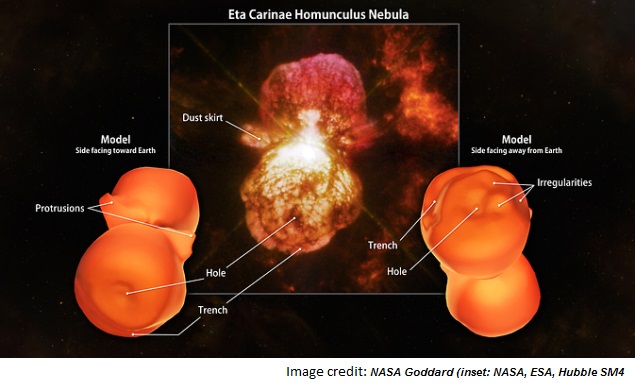- Home
- Science
- Science News
- 3D Print a Nebula at Home, Thanks to Nasa
3D Print a Nebula at Home, Thanks to Nasa

For this you need to download the plans that Nasa has made publicly available, feed them into your 3D-printing software, and play god by watching your very own Homunculus Nebula, a shell of gas and dust ejected during the star's mid-19th century eruption, form before your eyes.
Between 1838 and 1845, the massive binary system Eta Carinae underwent a period of unusual variability during which it briefly outshone Canopus, normally the second brightest star.
As a part of this event, which astronomers call the Great Eruption, a gaseous shell containing at least 10 and perhaps as much as 40 times the sun's mass was shot into space.
This material forms a twin-lobed dust filled cloud known as the Homunculus Nebula, which is now about a light-year long and continues to expand at more than 1.3 million mph (2.1 million km/h).
Wolfgang Steffen, astrophysicist at the National Autonomous University of Mexico, recently created the first ever 3D-printed model of the Homunculus Nebula by using a software called Shape.
"One of the questions we set out to answer with this study is whether the Homunculus contains any imprint of the star's binary nature, since previous efforts to explain its shape have assumed that both lobes were more or less identical and symmetric around their long axis," team member Jose Groh, astronomer at Geneva University in Switzerland was quoted as saying.
"The new features strongly suggest that interactions between Eta Carinae's stars helped mould the Homunculus," Groh added.
To create their 3D model of the nebula that now measures one full light year across, the researchers took 92 different slices of it using the European Southern Observatory's Very Large Telescope and its X-Shooter spectrograph.
They imaged near-infrared, visible and ultraviolet wavelengths, creating the most complete spectral map ever, according to Nasa.
That shape model was published in the journal Monthly Notices of the Royal Astronomical Society.
Catch the latest from the Consumer Electronics Show on Gadgets 360, at our CES 2026 hub.
Related Stories
- Samsung Galaxy Unpacked 2025
- ChatGPT
- Redmi Note 14 Pro+
- iPhone 16
- Apple Vision Pro
- Oneplus 12
- OnePlus Nord CE 3 Lite 5G
- iPhone 13
- Xiaomi 14 Pro
- Oppo Find N3
- Tecno Spark Go (2023)
- Realme V30
- Best Phones Under 25000
- Samsung Galaxy S24 Series
- Cryptocurrency
- iQoo 12
- Samsung Galaxy S24 Ultra
- Giottus
- Samsung Galaxy Z Flip 5
- Apple 'Scary Fast'
- Housefull 5
- GoPro Hero 12 Black Review
- Invincible Season 2
- JioGlass
- HD Ready TV
- Laptop Under 50000
- Smartwatch Under 10000
- Latest Mobile Phones
- Compare Phones
- OPPO A6 Pro 5G
- OPPO A6s
- OPPO Reno 15 Pro Max
- Honor Win RT
- Honor Win
- Xiaomi 17 Ultra Leica Edition
- Xiaomi 17 Ultra
- Huawei Nova 15
- Asus ProArt P16
- MacBook Pro 14-inch (M5, 2025)
- OPPO Pad Air 5
- Huawei MatePad 11.5 (2026)
- Xiaomi Watch 5
- Huawei Watch 10th Anniversary Edition
- Acerpure Nitro Z Series 100-inch QLED TV
- Samsung 43 Inch LED Ultra HD (4K) Smart TV (UA43UE81AFULXL)
- Asus ROG Ally
- Nintendo Switch Lite
- Haier 1.6 Ton 5 Star Inverter Split AC (HSU19G-MZAID5BN-INV)
- Haier 1.6 Ton 5 Star Inverter Split AC (HSU19G-MZAIM5BN-INV)

















